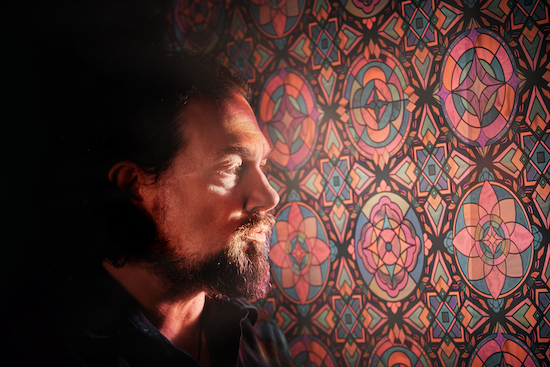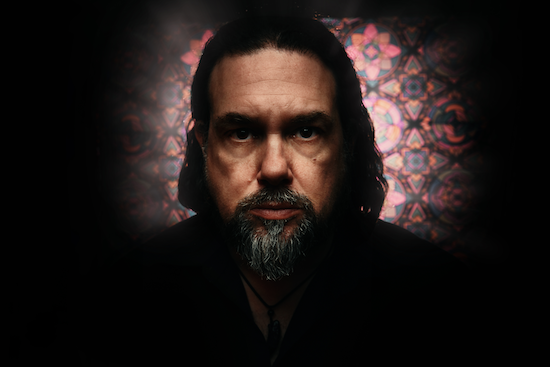Portraits by Al Overdrive
If you went down to the woods of southern California during the past two years, you might have been surprised to find a hoodless Greg Anderson taking a breath. Hiking in the forest and getting amongst the trees helped him “cope, exist and get by” during the pandemic.
“I’ve always been really fascinated by, and feel connected to, forests and trees,” Anderson tells me. “Growing up in the Pacific Northwest, that was a huge part of my surroundings and environment. And then living in California, we’re really fortunate, because it’s a diverse landscape – it has the desert, the ocean, and it also has these beautiful forests as well.”
The downtime of lockdown and being out in nature allowed him to slow himself. Running with the music industry via his label, Southern Lord, had become exhausting – he finally found a moment, or moments, to pause and take stock.
It might seem ironic that a specialist in low and slow music like Anderson needed to wind down. Playing in Sunn O))), the project he founded with Stephen O’Malley in the late nineties, he demarcates a meditative and relaxing space. He remains “completely blown away” by the success of the group, which was founded with no other intention but to “sit in a room and play through as many amplifiers as we possibly could hook up together”.
In January 2020, Sunn O))) played a handful of dates in Italy. Soon after, Anderson and bassist Tim Midyett fell ill. When they arrived in Paris at the end of the month, Anderson was too sick to leave his hotel room until show time. He could barely walk.
On one of the nights they played he had to lay down onstage. He passed out for around ten minutes enveloped in the oppressive fog and catastrophic volume of their set. He had only ever fallen asleep onstage before. Playing in Sunn O))), in his words, is akin to “leaving your body in some ways, or just really getting into a different space that is not necessarily your normal presence.”
But this had been different. Normally of an iron constitution on the road, he had been dangerously unwell. He returned home in early February. Then the world stopped as COVID-19 tightened its grip.
Once stuck at home, Anderson took on the mantle of “The Lord”. He had never been a home-recording musician. Instead he would work on ideas and take them to the band he was playing with at the time – whether that was avant-hardcore group Engine Kid followed by stoner-doom titans Goatsnake in the nineties, or latterly Sunn O))).
“It might sound strange, but I have just never been inspired to do something by myself,” he says.
Instead he holed up in his garage at night after his three children were in bed. He fiddled with his digital eight-track recorder until he could record demos and started to work on different pieces. He calls it “music of the night”, partly inspired by the circumstances of its inception, but also by the vibe he was seeking to channel.
He was listening to the scores of Bernard Herrmann, particularly Herrmann’s work on Alfred Hitchcock’s Vertigo and Psycho, as well as his music to J. Lee Thompson’s Cape Fear. Anderson also dug into the work of John Carpenter. Whereas Herrmann worked predominantly with strings and Carpenter with synths, Anderson wanted to evoke a similar atmosphere with guitars.
“I was coming up with this idea of how it would be really cool to incorporate this into heavy saturated guitars,” he says. “It seemed like I might capture this mood and this aesthetic, but with guitars.”
Anderson had received a commission to create a soundtrack for a horror anthology film called V/H/S/94. Released in October 2021, there was enough material that wasn’t used for it to be “reappropriated” for his debut album as The Lord, Forest Nocturne.
To his surprise, Anderson found isolation suited him. But he is a serial collaborator. He asked BIG|BRAVE singer Robin Wattie and current Alice In Chains frontman William DuVall to lay down vocals on two standalone singles, released as The Lord last year. ‘We Who Walk In Light’ saw DuVall, also the former guitarist of cult punk band Neon Christ, reach into the depths of his diaphragm to intone what he described as “a heavy metal Buddhist monk choir with Nusrat Fateh Ali Khan flying in for a cameo”.
The scratchy, spindly character of the guitar figure of ‘We Who Walk In Light’ was carried through to ‘THEME’, the opening track of Forest Nocturne. This lo-fi guitar sound erupts in other places, most notably ‘Forest Wake’. With its ‘War Pigs’-style siren, ‘Forest Wake’ sounds akin to the soundtracks of the seventies European exploitation horror of Jess Franco and Jean Rollin.
But its inspiration came from elsewhere – from the mid-frequency buzzsaw guitar tones of Entombed’s Left Hand Path and Dismember’s Like An Ever Flowing Stream. Anderson had long been taken by the “nasty grind” of those nineties Swedish death metal albums, but felt there was a way of reconceptualising it for a plague-ridden twenty-first century.
“To present it in a different sort of frame,” he says. “Something that was not traditional, with guttural vocals and hyperfast drums, but put in a warm, spacious and repetitive context.”
The pieces of Forest Nocturne have movement and flow. The rhythm of the album derives from it being more riff-orientated than Sunn O))), pushed along by Anderson’s percussive guitar-picking style. For demoing at home, he ripped a kick drum set to 60 bpm from YouTube and went from there.
Often with Sunn O))) Anderson has been asked why he has a problem with the drums. A strange thing to ask the man who wrote ‘What Love Remains’ on Goatsnake’s first album – a masterpiece of capture-and-release drumming and guitar playing. In Sunn O))), Anderson is the unorthodox caveman to Stephen O’ Malley’s more cerebral, art-informed half: “Give me a great riff and let’s just pummel the hell out of the thing,” he laughs.
When O’Malley heard Forest Nocturne, he commented that it would appeal to fans of Goatsnake. In some ways the album is the missing link between Sunn O))) and Goatsnake, unearthed almost a quarter of a century later. Goatsnake was a fusion of heavyweight riffs to soul, funk and Southern dirt-beneath-the-nails groove – encompassing Sly And The Family Stone, Black Oak Arkansas (whom Goatsnake covered), The Temptations, The Allman Brothers Band and Lynyrd Skynyrd.
For this new work as The Lord, Anderson had the quandary of finding a producer who could wrangle riffs and compositions that were influenced by Entombed and Bernard Herrmann in equal measure. By his own admission, Anderson had neither the skill nor the gear to record properly. He called producer Brad Wood to see if he might be interested.
Wood was a huge fan of Sunn O))). He has produced huge albums by Liz Phair, Sunny Day Real Estate and the Smashing Pumpkins. He seemed a good, counter-intuitive choice to finesse this material. Wood’s recording diary had been cleaned out by COVID, so they donned a couple of masks and got to work.
“It’s a really cool match, because he’s got this really interesting angle with everything that’s very different from anyone I’ve ever worked with before,” says Anderson. “Because, in Sunn O))), we’ve worked with some amazing people before, but they’re also very well versed in, and they’re known for, creating these really sonically guitar-heavy records. So working with somebody who is not known for that, and has a different take on everything, I thought, ‘This is perfect’, because I wanted this to be different.”

Anderson admits that whatever he writes is “going to have my stink on it”. But he is effusive about Wood’s ability to deconstruct his guitar parts and then reconstitute a song with piano, synths and sound effects, adding layers of reverb and atmosphere to bring out the hints of melodicism at the music’s core.
Anderson jokes that Wood is a “turd polisher” extraordinaire. But Wood was impressed with Anderson’s primitive guitar demos too. He often used them as the basis for building up the studio recordings. ‘Lefthand Lullaby I’ and ‘Lefthand Lullaby II’ saw Wood work with Anderson to reverse engineer the massive guitar theme on the second track to create the first – where sub-tones create an eerie and unsettling intimacy.
Likewise, when listened to on headphones, the piece ‘Deciduous’ sounds like being encased inside a tree. It pulses with the xylem and phloem of its vascular system – something claustrophobic, earthbound and alien all at once. The song transitions into the following track, ‘Old Growth’, like a smaller channel flowing into a greater tributary.
“We were trying to boil down and extract from the original idea, and then create a whole new track with it,” says Anderson. “I love the way that track [‘Old Growth’] came out, because it reminds me of the ocean. In some ways, it’s got this pulsing, but it’s also got this feeling of waves. And that’s what I was going for: something more liquid with that feeling to it.”
‘Deciduous’ and ‘Old Growth’ convey a new impression of Anderson’s oversaturated amplifiers. They move his music away from the Sunn O))) notion of pushing troubled air around a suffocating space. Whereas Sunn O))) is interpreted as either billowing and harsh, or imposing and monumental, the work of The Lord is organic and fungible – pulpy in every sense.
“I feel like I’m in a bubble so much with this stuff,” says Anderson. “Especially since with Sunn O))) I’ve been doing this for a good part of my life. We’ve been doing Sunn O))) for 22, 23 years now. To me, a lot of what we do feels normal. I don’t mean that in a negative way. It’s my life and who I am, and I’m used to it. So the language of Sunn O))) to me is not foreign at all. It’s hard for me to sometimes step back and realise how strange, unorthodox and foreign it could be to other people. So, with this record, I hope it appears to be different from Sunn O))).”
That doesn’t mean he can’t call on some old friends. The album closes with ‘Triumph Of The Oak’ featuring a guest vocal from longtime collaborator and Mayhem frontman Attila Csihar. He sounds like a satyr summoned from the heart of the tree itself by Anderson’s most necro riffs since Sunn O)))’s Black One album.
Cshar’s involvement seems apposite when you take in the album’s cover. Anderson commissioned Dan Seagrave, the cover artist of both Left Hand Path and Like An Ever Flowing Stream. The cover art’s blue-hued gnarled woodland church echoes the image of Trondheim’s Nidaros cathedral on the cover of Mayhem’s 1994 black-metal classic De Mysteriis Dom Sathanas. Too often these days, like the ecclesiastical arson that accompanied black metal’s second wave, California’s forests only seem good for burning as well.
“I had no idea what it was gonna sound like with him on it,” says Anderson of Csihar’s performance. “When he sent back the vocals, I was like, this guy’s insane. He nailed it. I would never have thought that was gonna be what he did. But it’s really cool. You know, he’s always surprising me.”
Another Sunn O))) and Goatsnake collaborator, Petra Haden, has provided vocals and violin to a further six tracks with Anderson, promising another release from The Lord later this year.
“If Forest Nocturne is the dark, this album with Petra is the light. It’s still very powerful and heavy, but it’s got a very different atmosphere to it,” says Anderson.
Whether you’re venturing into the darkness or reaching for the light, it’s best to have The Lord with you.


